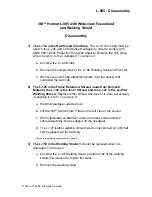
Model HFP01 Soil Heat Flux Plate
5
7.1 Placement in Soil
The standard set of sensors for measuring soil heat flux includes an HFP01 Soil
Heat Flux Plate, TCAV Averaging Soil Thermocouple, and CS616, CS650, or
CS655 water content reflectometer. These sensors are installed as shown in
FIGURE 7-1. Placement of the sensors
The location of the heat flux plate and thermocouple should be chosen to be
representative of the area under study. If the ground cover is extremely varied,
an additional set of sensors is required to provide a valid soil heat flux average.
Use a small shovel to make a vertical slice in the soil. Excavate the soil to one
side of the slice. Keep this soil intact so that it can be replaced with minimal
disruption.
The sensors are installed in the undisturbed face of the hole. Measure the
sensor depths from the top of the hole. With a small knife, make a horizontal
cut 16 cm below the surface into the undisturbed face of the hole. Insert the
heat flux plate into the horizontal cut.
Install the HFP01 in the soil such that the side with the red label
is facing the sky and the side with a blue label is facing the soil.
To make quality soil heat flux measurements, the HFP01
plate must be in full contact with the soil.
Never run the sensor cable directly to the surface. Rather, bury the sensor cable
a short distance back from the hole to minimize thermal conduction on the
cable wires. Replace the excavated soil back into its original position after all
the sensors are installed.
NOTE
CAUTION
Partial emplacement of the HFP01 and the TCAV
sensors is shown for illustration purposes. All
sensors must be completely inserted into the soil face
before the hole is backfilled.





































